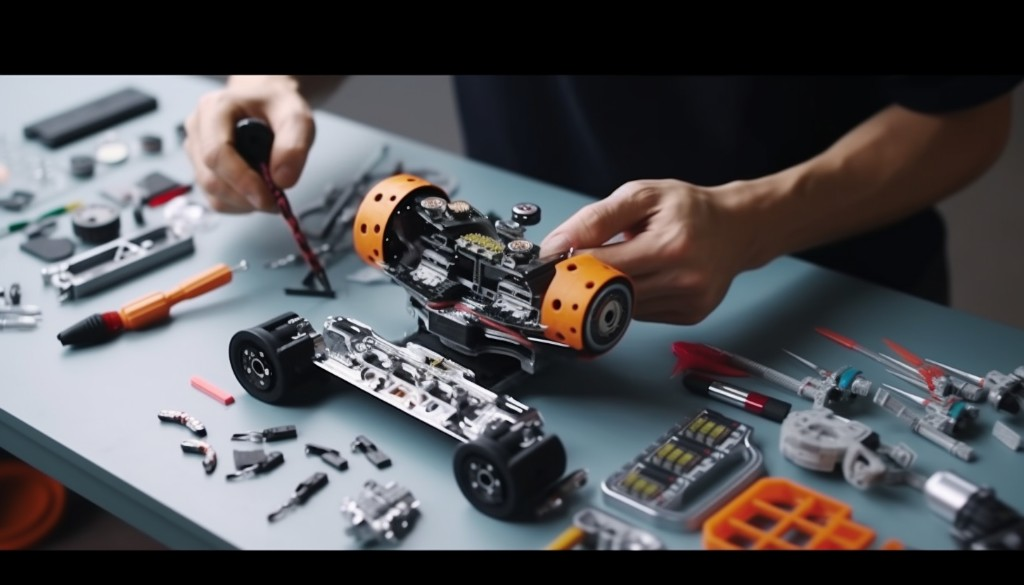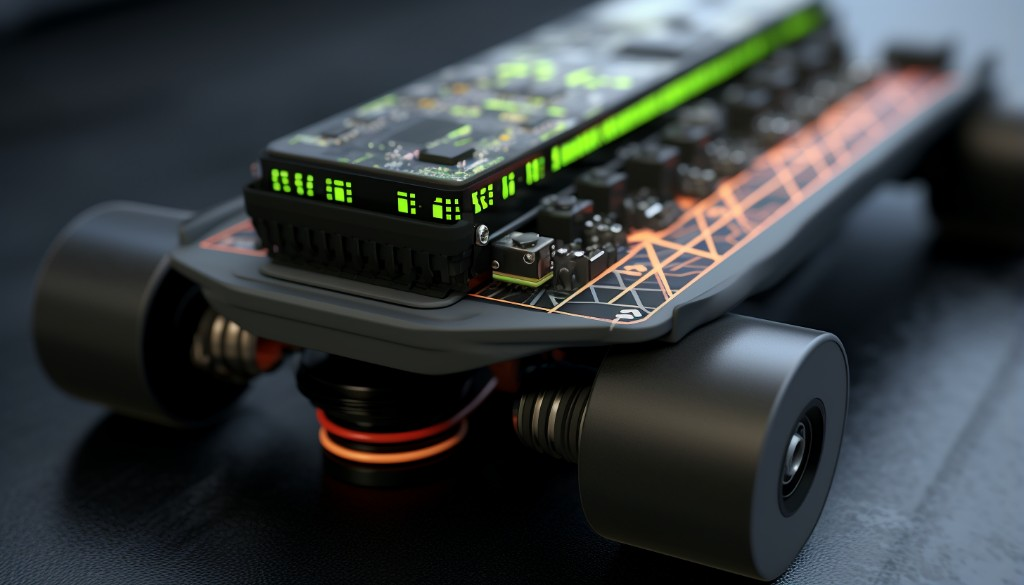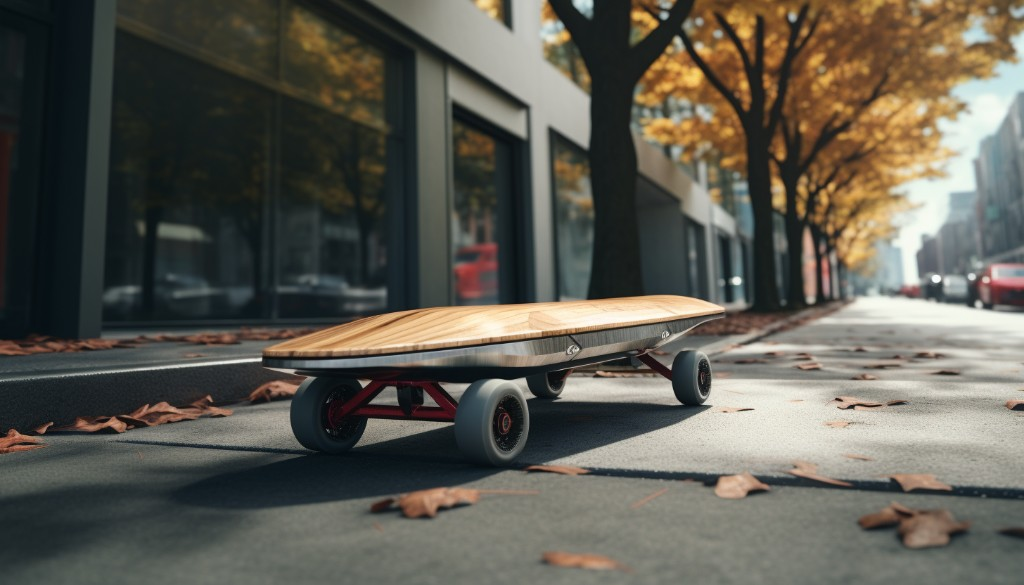Imagine cruising down the street, the wind in your hair, aboard your trusty electric skateboard. But have you ever paused mid-ride to wonder just how long this thrilling experience will last? The longevity of an electric skateboard hinges on several factors, including battery life, maintenance, usage, and even the type of motor it houses.
What we’ll cover
- Deciphering E-Skateboard Lifespan
- Battery Life Expectancy
- Maintenance and Upkeep Tips
- Lengthening E-Skateboard Life
- Hub Motors and Lifespan
- Charging Time for E-Skateboards
- The Effect of Usage on Lifespan
Now, let’s dive into the nitty-gritty of electric skateboard longevity and convince you why caring for your ride is an absolute must!
Understanding Electric Skateboard Lifespan
When it comes to the lifespan of an electric skateboard, there’s a myriad of factors that come into play. Much like a car or a bicycle, the longevity of an e-skateboard depends on its components, maintenance, and overall design.
Let’s imagine for a moment that your electric skateboard is like a pet. Like any pet, it needs regular care and attention. The quality of food you feed it (in this case, the quality of its components), the love and attention you give it (your maintenance habits), and the genetic makeup (the skateboard’s design) all determine how long it will thrive.

Components influencing Electric Skateboard Lifespan
To continue with our pet analogy, think of the components of your electric skateboard as its diet. The better the quality of its food, the longer and healthier a life it will lead.
One crucial aspect that directly influences how long an electric skateboard lasts is the battery. Just as different breeds of dogs have different lifespans, so too do different types of electric skateboard batteries. Some e-skateboards use lithium-ion batteries, while others use lead-acid ones. Each has its pros and cons, but generally, lithium-ion batteries have a longer lifespan.
The material of the board itself is another significant factor. Decks made from high-quality materials such as bamboo or maple are more durable and can withstand wear and tear better than those made from lower-quality materials.
The power of the motor and the size of the skateboard also play essential roles. A more powerful motor might mean faster speeds and more fun rides, but it can also put more strain on the board’s battery and reduce its lifespan. Similarly, a larger board might be more comfortable to ride, but it could also be heavier, placing more stress on the motor and battery.
Lastly, the rider’s weight significantly impacts the skateboard’s lifespan. Heavier riders might put more strain on the board and its components, leading to faster wear and tear.
Role of Maintenance in Skateboard Lifespan
Now let’s consider the care and attention you give your electric skateboard – its maintenance. Regular maintenance is like taking your pet for regular vet check-ups. It helps to catch any potential issues early on and can significantly extend your board’s lifespan.
One crucial aspect of maintenance is your charging habits. The board battery is like the heart of your e-skateboard – it powers everything. Overcharging or frequently draining the battery completely can shorten its lifespan. Thus, it’s essential to charge your electric skateboard battery correctly and avoid leaving it at 0% or 100% for extended periods.
Other maintenance tasks, like regularly cleaning the board and its components, checking for any loose screws or parts, and ensuring the wheels are in good condition, also play a crucial role in determining how long your electric skateboard will last.
In essence, the lifespan of an electric skateboard is a complex interplay of its components, maintenance habits, and overall design. By understanding these factors and taking steps to optimize them, you can ensure that your e-skateboard lives a long and healthy life, giving you many miles of fun rides.

Electric Skateboard Battery Lifetime
A pivotal component of any e-skateboard, the electric skateboard battery, is what breathes life into your ride. It’s like the heart of your board, and just like our hearts, skateboard batteries have a lifespan. This lifespan is usually measured in charge cycles, but it’s not as simple as just counting the number of times you plug in your charger.
Different Types of Batteries in Electric Skateboards
Lithium-Ion Batteries
One of the most common types of batteries found in electric skateboards are lithium-ion batteries, often abbreviated as li-ion batteries. The beauty of these batteries lies in their high energy density and low self-discharge. However, their life expectancy isn’t infinite. Typically, a li-ion battery can last anywhere from 2 to 3 years if properly cared for. But remember, this duration also depends on how frequently and intensely you use your e-skateboard.
Lithium Polymer Batteries
Next up, we have lithium polymer batteries, often referred to as lipo batteries. These types of batteries offer a higher discharge rate and capacity compared to li-ion batteries. However, their lifespan can be slightly shorter, usually around 2 years with proper care and usage. Keep in mind that this is just an estimate; your mileage may vary depending on how you use and maintain your lipo battery.
LiFePo4 Batteries
Lastly, there’s another type of battery you might come across: LiFePo4 batteries. These are known for their safety and stability, as well as their longer battery lifespan compared to other types. However, they can be more expensive and have a lower energy density than their counterparts.

Factors Affecting Skateboard Battery Life
Riding Style and Frequency of Stops
Your riding style can significantly impact the battery life of your e-skateboard. If you’re a speed demon who loves to max out your board’s throttle, you’re going to consume more power than someone who cruises at moderate speeds. Similarly, if you’re frequently stopping and starting, your board battery will drain faster.
Rider’s Weight
The weight of the rider is another factor that can influence battery life. Simply put, the heavier the rider, the harder the board battery has to work, and the quicker it will drain. So if you’re on the heavier side, you might find your battery life slightly reduced compared to lighter riders.
Frequency of Use
The frequency of use also plays a role in your battery life. If you’re riding your electric skateboard daily for long distances, your board battery will naturally wear out faster than if you were using it less frequently.
Weather Conditions
Lastly, weather conditions can affect your battery life. Cold weather can reduce the capacity of your board battery, while extremely hot weather can lead to overheating and potential damage.

Number of Times a Skateboard Battery Can be Charged
Now, let’s talk about charge cycles. A charge cycle refers to the process of charging a battery from 0% to 100% and then discharging it back to 0%. On average, most skateboard batteries can handle between 500 to 1000 charge cycles before experiencing significant voltage sag.
Voltage sag refers to the decrease in voltage that occurs as a battery discharges. When a battery experiences voltage sag, it’s unable to deliver the same amount of power as when it was fully charged. This can result in reduced performance and speed of your e-skateboard.
But remember, these numbers are just averages. The actual number of charge cycles your battery can handle depends on several factors, including the battery types we discussed earlier, as well as the factors affecting battery life.
So, while we can’t tell you exactly how long your electric skateboard will last, understanding these aspects can help you maximize the lifespan of your ride. After all, knowledge is power, and in this case, it’s battery power!
Maintenance and Care for Electric Skateboard
An electric skateboard, just like any other device, requires a certain level of care and maintenance to ensure its longevity. The way you use and care for your skateboard, how you handle its charging and discharging, as well as how you store it can significantly influence the lifespan of your board.

Regular Use and Care of the Skateboard
The regular use and care of an electric skateboard can have a significant impact on its longevity. A few factors to consider include usage habits, the type of terrain you ride on, and the general wear and tear that the board undergoes.
Your usage habits play a critical role in the life of your electric skateboard. Consistent use without overworking the board is recommended. If you’re pushing the board to its limits every time you ride it, this can put unnecessary strain on the components, especially the electric skateboard batteries. Try to avoid extremely rough terrains as they can lead to excessive wear and tear on the wheels and deck.
The type of terrain you usually ride on can also affect the lifespan of your board. Smooth, flat surfaces are less likely to cause damage to the board and its components compared to rough or uneven terrains. Keep in mind that while your board may be designed to handle a variety of surfaces, continually exposing it to harsh conditions can shorten its life.
Proper Charging and Discharging of Batteries
The health of the board battery is another critical factor in determining how long your electric skateboard will last. The way you charge and discharge the battery pack can greatly influence its lifespan.
It’s recommended to avoid running your board battery down to zero before recharging it. Instead, aim to recharge the battery when it reaches around 20% power. This practice can help prolong the life of the battery.
Similarly, it’s not advisable to always charge your battery to a full charge. Consistently charging the battery to 100% can stress it out and reduce its overall lifespan. Aiming for an 80-90% charge is a good rule of thumb to follow.
Also, never leave your battery on the charger after it’s fully charged. Overcharging can lead to overheating, which can damage the battery pack and reduce its lifespan.

Appropriate Storage of Electric Skateboards
The conditions in which you store your electric skateboard can also affect its longevity. If you’re not planning on using your board for a long time, it’s important to store it properly to ensure it remains in good condition.
If you’re storing your board for an extended period, make sure to store it in a cool, dry place away from direct sunlight. High temperatures and humidity can damage the electric components of the board, including the battery.
Before storing your board for a long time, make sure it’s clean and dry. Dirt and moisture can cause corrosion, which can damage various components of the board. Also, if you’re storing the board for more than a month, it’s a good idea to partially charge the battery to around 50% to help maintain its health.
By adhering to these maintenance and care practices, you can significantly extend the life of your electric skateboard and ensure it continues to provide you with reliable transportation and fun rides for years to come.
Ways to Prolong Electric Skateboard Life
Caring for your e-skateboard goes beyond just basic maintenance. There are additional measures you can take to ensure that your electric skateboard lasts as long as possible, and it’s not as complicated as you might think. By focusing on two key areas – enhancing battery life and improving overall performance – you can significantly prolong the life of your board.
Tips to Enhance Skateboard Battery Life
The heart of any electric skateboard is its battery. It’s like the fuel tank in your car – without it, you’re not going anywhere. So, how can you ensure that your battery life stays healthy for longer?
First, consider the type of battery your board uses. Many electric skateboards use lithium polymer batteries. While they provide an excellent power-to-weight ratio, they can be sensitive to overcharging, extreme temperatures, and physical damage. Therefore, practicing good battery management is crucial. This means charging your battery only when needed and not leaving it plugged in for extended periods after it’s fully charged.

Another critical factor is managing voltage sag. Voltage sag refers to the decrease in voltage that occurs when a high current is drawn from the battery. If not managed properly, voltage sag can reduce both your battery life and the performance of your board. To combat this, try to avoid extreme acceleration or hill climbing when your battery is low. These activities draw a high current, which can lead to significant voltage sag.
Lastly, don’t forget about regenerative braking – a feature found in many electric skateboards that allows the motor to act as a generator during braking, converting kinetic energy back into stored energy in the battery. By using regenerative braking effectively, you can extend your battery life while also reducing wear on your braking system.
Techniques to Improve Overall Skateboard Performance
Aside from battery life, there are other ways to improve the longevity of your electric skateboard. Focusing on motor efficiency, wheel quality, and rider skill level can all contribute to a longer-lasting board.
Motor efficiency is key. Remember, the more efficiently your motor runs, the less strain there is on your battery and the rest of your board. Regularly checking and cleaning your motor can help maintain its efficiency. Also, be mindful of how you ride. Constantly pushing your board to its limits can overwork the motor, reducing its lifespan.
The quality of your skateboard wheels can also play a significant role in overall performance. High-quality wheels can provide better traction and smoother rides, reducing the amount of stress on your board’s components. Plus, they tend to last longer than cheaper alternatives.

Finally, don’t overlook the impact of rider skill level. An experienced rider who knows how to balance properly and use features like regenerative braking effectively can significantly reduce wear and tear on an electric longboard. So, don’t rush to hit top speeds if you’re still getting the hang of riding. Take your time to learn and practice – it’ll pay off in the long run, both for you and for your board.
By applying these tips and techniques, you can ensure that your electric skateboard stays in top shape for many rides to come. And remember, prolonging your board’s life isn’t just about saving money – it’s also about maximizing the fun and freedom that comes with riding an electric skateboard. So, treat your board well, and it’ll return the favor.
Closing Thoughts
The lifespan of an electric skateboard is heavily influenced by the care and usage it receives. Regular maintenance plays a crucial role in ensuring its longevity, involving tasks such as timely battery charging and routine check-ups of all components. Furthermore, responsible usage, such as avoiding extreme weather conditions and rough terrains, is key to preventing premature wear and tear. When it comes to long-term storage, proper practices can also help extend your skateboard’s life by protecting the battery and other vital parts from potential damage. Thus, understanding and implementing these factors will not only enhance your riding experience but also maximize the lifespan of your electric skateboard.
Frequently Asked Questions
How long does an electric skateboard battery last on a single charge?
An electric skateboard battery typically lasts between 10 to 20 miles on a single charge, depending on the model, battery capacity, and riding conditions.
What factors affect the lifespan of an electric skateboard?
The lifespan of an electric skateboard is influenced by various factors including the quality of the board, regular maintenance, responsible usage, riding conditions, and battery care.
How can I extend the life of my electric skateboard?
You can extend the life of your electric skateboard by regularly maintaining it, using it responsibly, avoiding extreme weather conditions, charging the battery properly, and storing it correctly during periods of non-use.
How long does it take to fully charge an electric skateboard?
The time it takes to fully charge an electric skateboard can vary depending on the model and battery capacity. On average, it can take anywhere from 2 to 5 hours.
Can the battery of an electric skateboard be replaced?
Yes, the battery of an electric skateboard can usually be replaced. However, it’s recommended to have it done by a professional to ensure proper installation and avoid potential damage to the board.
